1995 Oldsmobile Cutlass Supreme brakes
[x] Cancel search: brakesPage 150 of 340
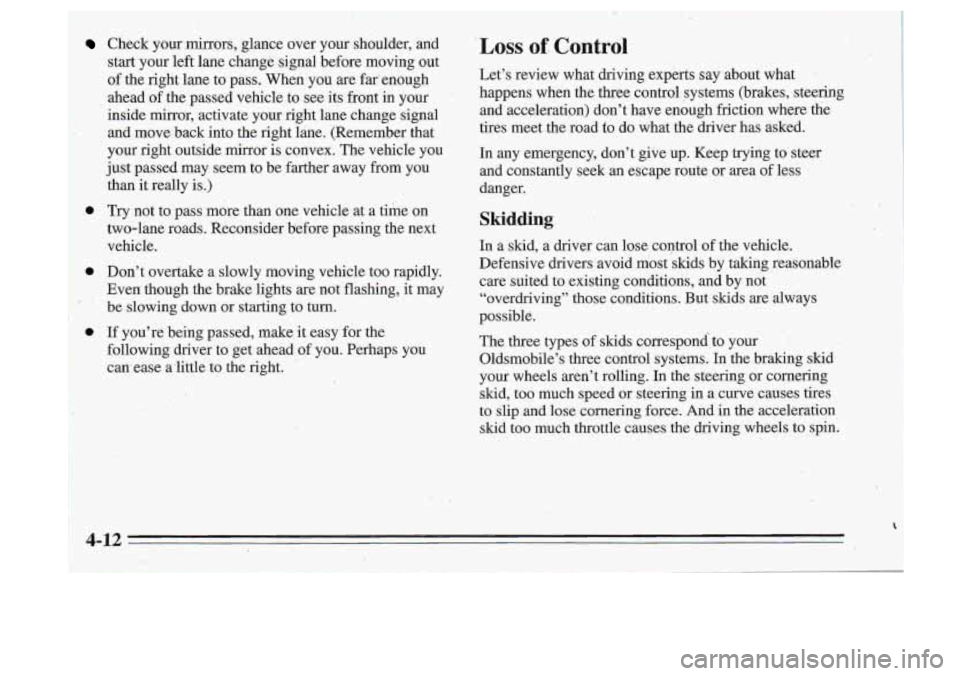
0
0
.. ..
Check your mirrors, glance over your shoklder, and
start your left lane change signal before moving out
of the right lane to pass. When you are far’enough
ahead of the passed vehicle to see its front in your
inside mirror, activate your right$ lane ,change signal
and move back into the right lane. (Remember that
your right outside mirror
is convex. The vehicle you
just passed may seem to be,farther away from
you
than it really is.)
Try not to pass more than one vehicle at a tihe on
two-lane roads. Reconsider before passing the next
vehicle.
Don’t overtake a slowly moving vehicle too rapidly.
Even though the brake lights are not flashing, it.may
be slowing down or starting tu turn.
If you’re being passed, make it easy for the
following driver to get ahead of you. Perhaps you
cmease a,little to the right.
.. : ‘ . .. ~
Loss of Control
Let’s review what driving experts say about what ’
happens when the three control systems (brakes, steering
and acceleration) don’t have enough friction where the
tires meet .the road
to do what ‘the driver has asked.
In any emergency, don’t give up. Keep trying to steer and constantly seek an es-c-gpe route or area
.~f less
danger.
Skidding
In a skid, a driver can lose control of the vehicle.
Defensive drivers avoid most skids by taking reasonable
care suited to existing conditions, and by not
“overdriving” those conditions. But skids are always
possibk.
The three types of skids correspondjo your
Oldsmobile’s three control systems. In the braking skid
your wheels aren’t rolling.
In the steering or cornering
skid, too much speed or steering in
a curve causes tires
to slip and lose cornering force. And in the acceleration
skid too much throttle causes the driving wheels to,spin.
, .*
I
4-12
Page 154 of 340
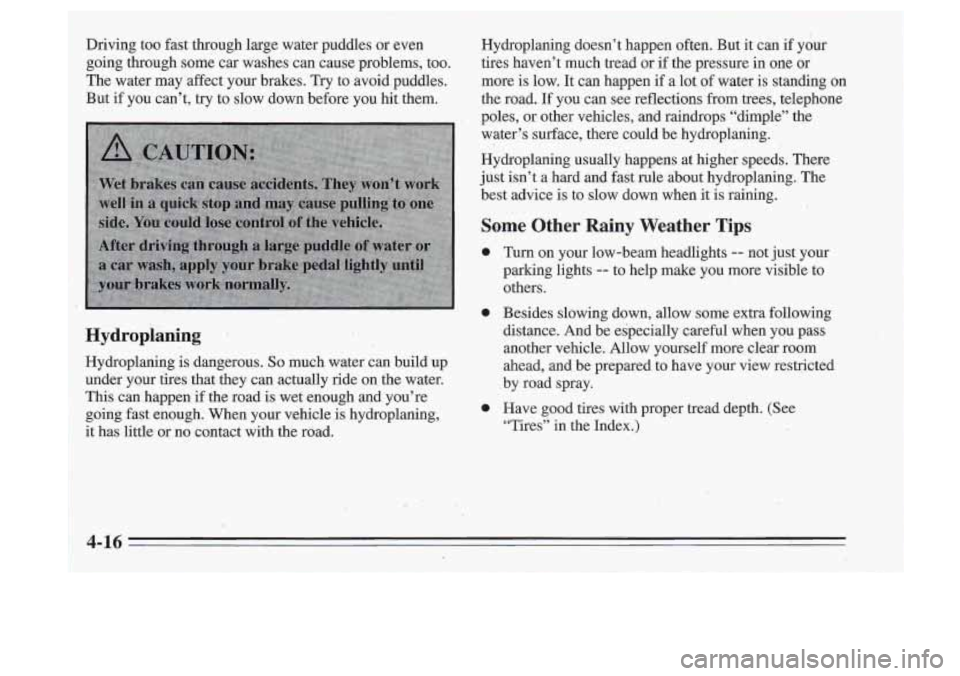
!
Driving too fast through large water puddles or even going through some car washes can cause problems, too.
The water may affect your brakes. Try to avoid puddles.
But if you can’t, try to slow down before you hit them.
Hydroplaning
Hydroplaning is dangerous. So much water can build up
under your tires that they can actually ride on the water.
This can happen if the road is wet enough and you’re
going fast enough. When your vehicle is hydroplaning,
it has little or no contact with the road. Hydroplaning doesn’t .happen often. But
it can if your
tires haven’t much tread or
if the pressure in one or
more
is low. It can happen if a lot, of water is standing on
the road. If you can see reflections froin trees, telephone
poles,
or other vehicles, and raindrops “dimple” the
water’s surface, there could be hydroplaning.
Hydroplaning usually happens at higher speeds. There
just isn’t a hard and fast
rule about hydroplaning. The
best advice
is to slow down when it is iaining.
Some Other Rainy weather Tips
1
0
0
0
,Turn on your low-beam headlights -- not just your
parking lights
-- to help make you ,more visible to
others.
Besides slowing down, allow some extra following distance. And be especially carefbl when you pass
another vehicle. Allow yourself more clear room
ahead, and, be prepared to have your view restricted
by road spray.
Have good tires with proper tread depth. (See “Tires” in the Index.)
Page 159 of 340
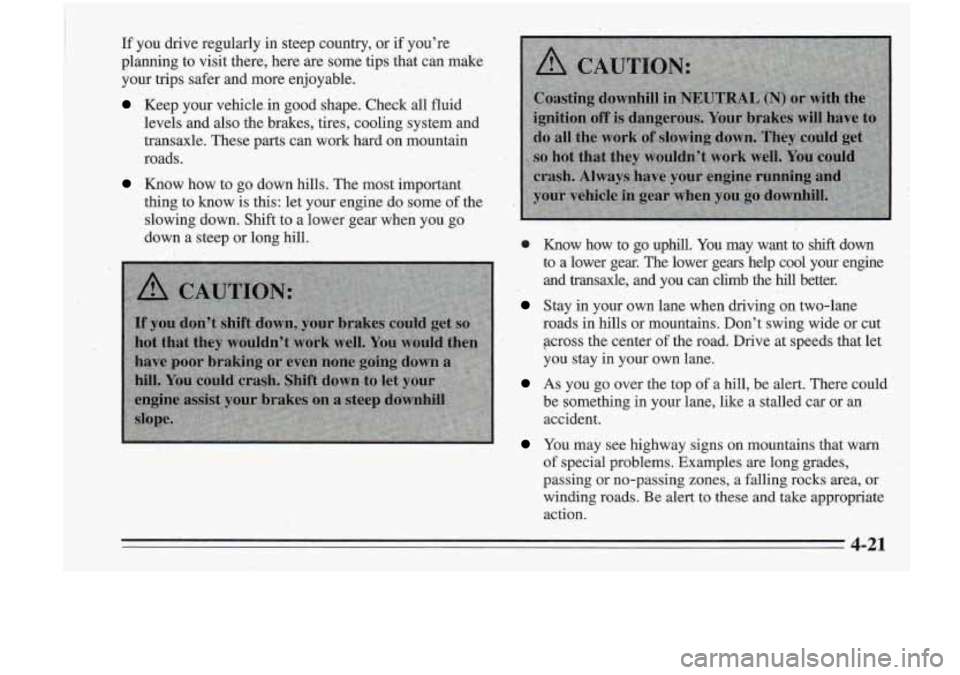
If you drive regularly in steep country, or if you're
planning to visit there, here are some tips that can make
your trips safer and more enjoyable.
Keep your vehicle-in good shape. Check all fluid
1evel.s and. also the brakes; tires, cooling system and
..
transaxle. These parts can work,hard on mountain
roads.
Know how to go down hills. The most important
thing to know is this: let your' engine do some of the
slowing down. Shift to a lower, gear when you go
down a steep or long hill.
e Know, how to gauphill. You may want to shift down
to a lower gek The 1ower.gearshelp cool your engine
and tramaxle, and you can climb the hill better.,
Stay in your own lane when driving on two-lane
roads
iri hills or mountains. Don't swing wide or cut
'% across the center of the road, Drive at speeds that let
you stay
in your own lane.
As you go over the top of a hill, be alert. There, dould
be something in your lane, like a stalled ca~
or an
accident.
You.m&y see highway ,signs on mountains that warn
,of special problems. Examples are long grades,
passing
or no-passing zones, a falling rocks &ea, or
winding roads. Be aleq to these aad'take appropriate
action.
,,
4-21
Page 161 of 340
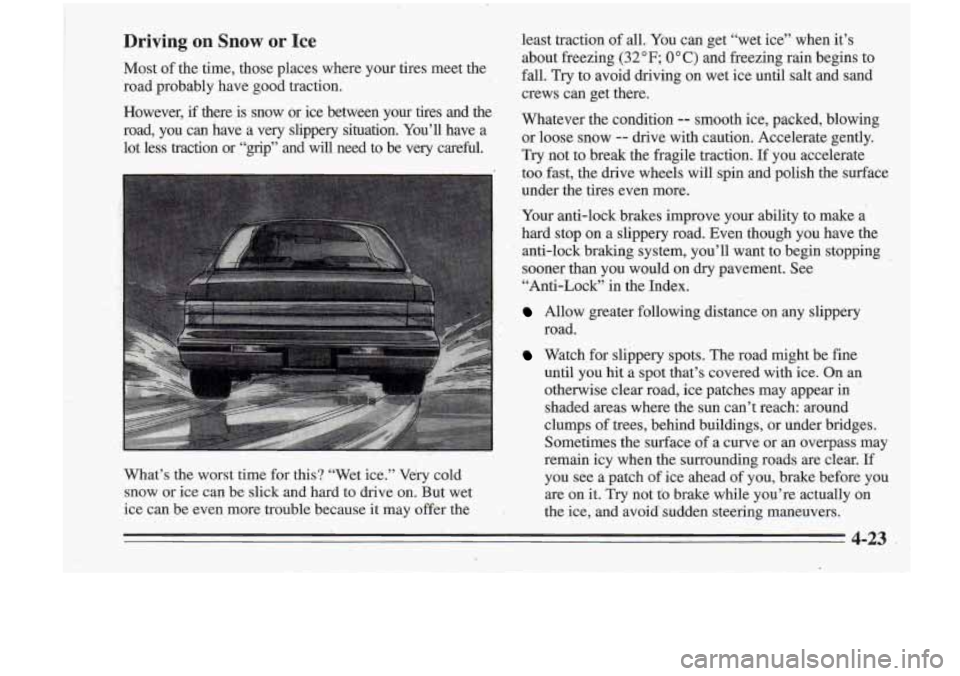
Driving on Snow or Ice
Most of the time, those places where your tires meet the
road probably have good traction. least traction
of all.
You can get “wet ice” when it’s
about freezing
(32°F; OOC) and freezing rain begins to
fall. Try to avoid driving on wet ice until salt and sand
crews can get there.
road.
Watch for slippery spots. The road might be fine
until you
hit a spot that’s covered with ice. On an
otherwise clear road, ice patches may appear in
shaded areas where the sun can’t reach: around
clumps of trees, behind buildings, or urider bridges.
Sometimes the surface of a curve or an averpass may
remain icy when the. surrounding roads
are clear. If
too. fast, the drive wheels will spin and polish the surface
under the tires even more.
‘Your anti-lokk brakes improve your ability to make a
hard stop
on a slippery road. Even though you have the
anti-lock braking system, you’ll want to begin stopping
sooner than you would on dry pavement. See
“Anti-Lock”
in the Index.
Allow greater following distance on any slippery
What’s the worst time for this? “Wet ice.”
V&y cold
snow or ice can be slick and hard to drive on. But wet
ice can be even more, trouble because
it may offer the you
see a-patch of ice ahead of you, brake before you
are on it. Try not
to brake while you’re actually on
the ice, and avoid‘sudden steering maneuvers.
4-23 .
Page 169 of 340
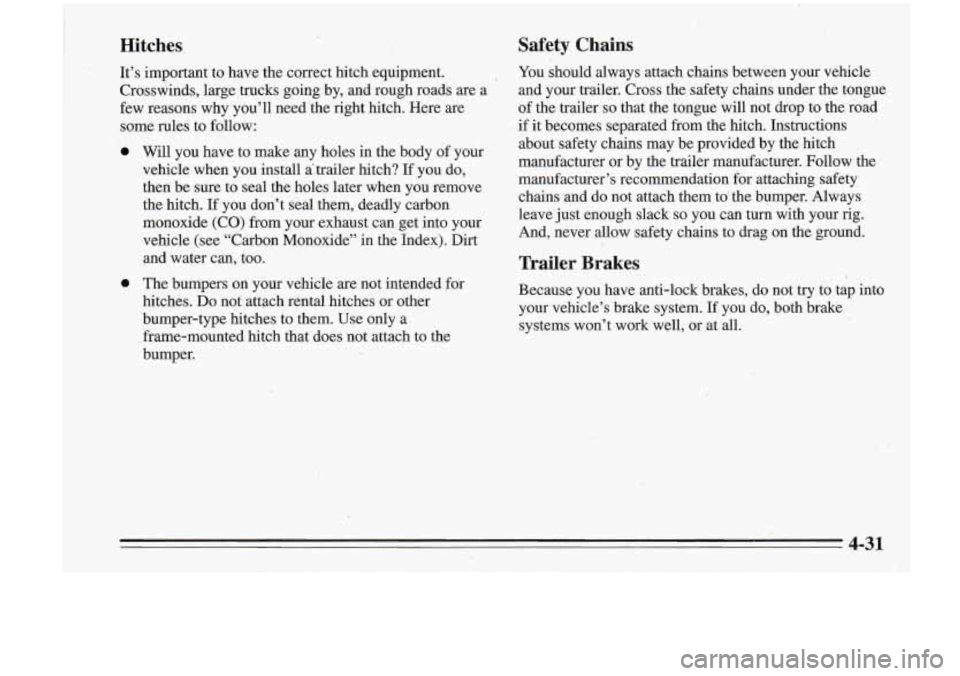
Hitches
It’s important to have the correct hitch equipment.
Crosswinds, large trucks going by, and rough roads are
a
few reasons why you’ll need’the right hitch. Here are
some rules to follow:
0
0
Will you have to make any holes in the body of your
vehicle when you install a:trader hitch?
If you do,
then be sure to seal the holes later when you remove
the hitch.
If you don’t seal them, deadly carbon
monoxide (CO) from your exhaust can get into your
vehicle (see “Carbon Monoxide”
in the Index). Dirt
and water can, too.
The bumpers on your vehicle are not intended for
hitches. Do not attach rental lvtches or other
bumper-type hitches to them. Use only a
frsune-mounted hitch that does not attach to the
bumper.
Safety Chains
You should always attach chains between your vehicle
and your trailer. Cross the safety chains under the tongue
of the trailer
so that the tongue will not drop to the road
if it becomes separated from the.hitch. Instructions
about safety chains may be provided by the hitch
manufacturer or by the trailer manufacturer. Follow the
manufacturer’s recommendation
for attaching safety
chains and do not attach them to‘the bumper. Always
leave just enough slack
so you can turn with your rig.
And, never allow safety chains to drag on the ground.
Trailer Brakes
Because you have anti-lock brakes, do not try to tap into
your vehicle’s brake system.
If you do, both brake
systems won’t work well, or at all.
Page 170 of 340
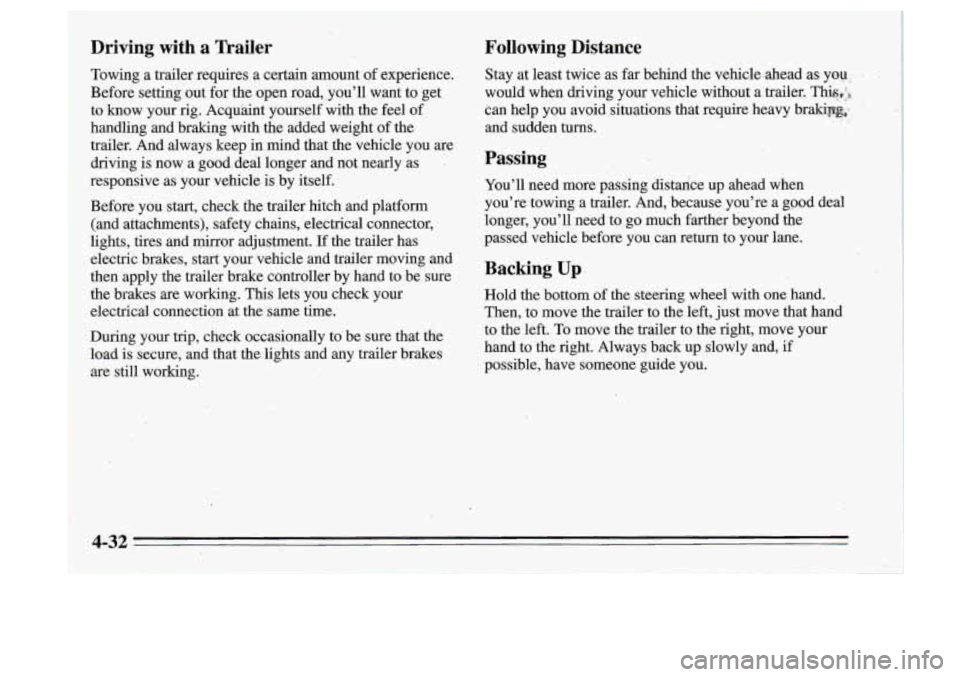
-
I
,'
Driving with a Trailer Following Distance
Towing a trailer requires a certain amount
of experience. Stay at least twice as far behind the vehicle .ahead as- you - .
Before setting out for the open road, you'll want to get would when driving your veh\
icle without a trailer. This$,
to know your rig. AcquQint yourself with the feel of can help you avoid situations that require heavy br-it
and sudden turns.
handling and braking with the added weight of the
trailer. And always keep in mind that ,the vehicle you are
driving is now a good deal longer
and not nearly as . Passing
responsive as your vehicle is by itself. You'll need more passing distance up ahead when
Before you start, check the.trailer hitch and platform you're' towing a trailer. And, because you're a good deal
(and attachments), safety chains, electrical connector, longer, \
you'll need to go much farther beyond the
lights, tires and mirror adjustment.
If the trailer has passed vehicle before you can return to your \
lane.
electric brakes, start your vehicle and trailer moving and
the brakes are working. This lets you check ,your Hold the bottom
of the steering wheel with one hand.
electrical connection at the same time. Then, to move the trailer
to the left, just move that hand
During your
trip, check occasionally to' be sure that the to the left.
To move the trailer to the right, move your
load is secure, and that the lights and any trailer brakes hand to the right. Always back up slowly and, if
are still working. possible. have someone guide you.
.. . ~.
then apply the trailer brake controller by hand to be sure Backing Up
?'
Page 171 of 340
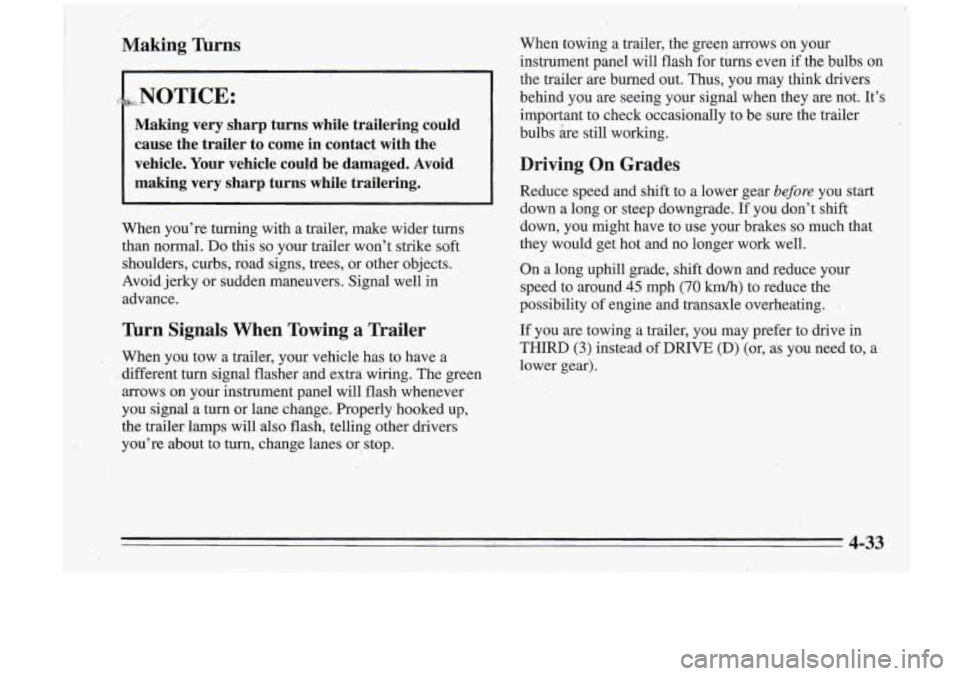
Making ’hrns When towing a trailer, the green arrows on your
.~ ~~~ ~ ~~ ~ instrument panel will flash for turns even if the bulbs on
the trailer are burned oat. Thus, you may think drivers
c e.. NOTICE: behind you are seeing your signal when they are not. It’s
, important to check occasionally to be sure the trailer
Making very sharp turns while trailering could bulbs ‘be still w’orking.
cause the trailer to come in contact with the
vehicle. Your vehicle could
be damaged. Avoid Driving On Grades
I- making very sharp turns while trailering. I
When you’re turning with a trailer, make wider turns
than normal.
Do this so your trailer won’t strike soft
shoulders, curbs, road
signs, trees, or other objects.
Avoid,jerky or sudden maneuvers. Signal well in
advance.
lhrn Signals When Towing a Trailer
When you tow a trailer, your vehicle has to have a
different turn signal flasher and extra wiring. The green
arrows on your instrument panel will flash whenever
you signal a turn
or lane change. Properly hooked up,
the trailer lamps
will also flash, telling other drivers
you’re about to turn, change lanes or,stop. Reduce
speed and shift to a lower gear
before you start
down a long or steep downgrade. If you don’t shift
down, you might have to use your brakes
so much that
they would get hot and no longer work well.
On a long uphill grade, shift down and reduce your
speed to around
45 mph (70 kdh) to reduce the
possibility of engine and transaxle overheating.
If you are towing a trailer, you may prefer to drive in
THIRD (3) instead of DRIVE (D) (or, as you need to, a
lower gear).
4-33
Page 172 of 340
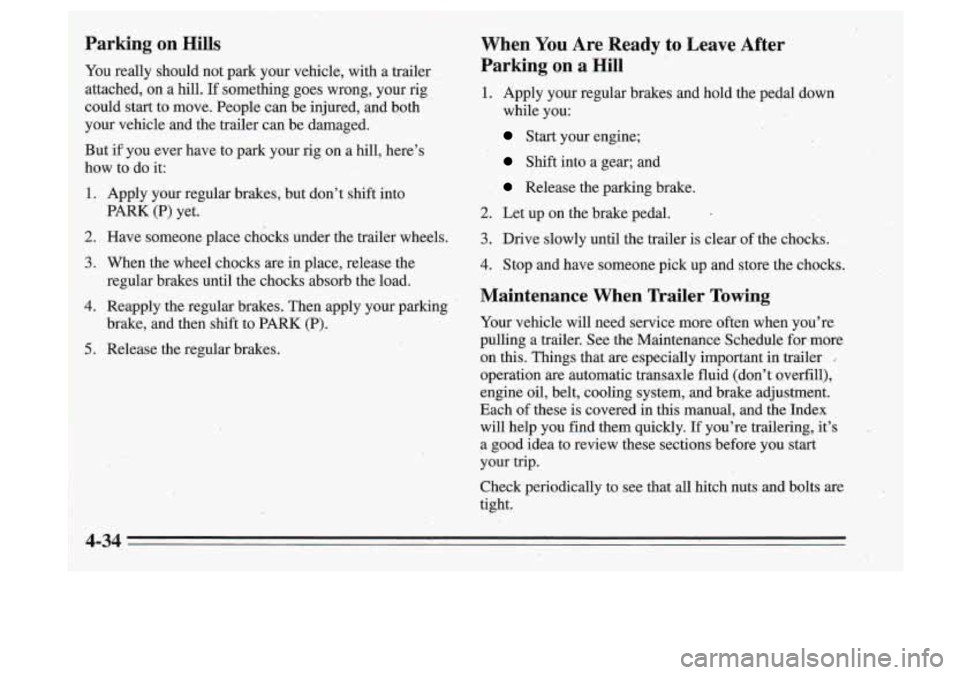
Parking on Hills
You really should not park your vehicle, with a trailer
attached,
on a hill. If something goes wrong, your rig
could start to move. People can be injured, and
both^
your vehicle and the trailer can be darnaged.
But if you ever have to park your rig on a hill, here’s
how to do it:
.I. Apply your regular brakes, but don’t shift into
.. !PARK (P) yet.
2. ‘Have someone place chocks under the trailer wheels.
3. When the wheel chocks are in place, release the
regular brakes until the chocks absorb the load.
4. Reapply the regular brakes. Then apply your parking
brake, and then shift to PARK
(P).
When You Are Ready to Leave After
Parking o,n a
Hill
1. Apply your regular brakes and hold the pedal down
8’. .
while you:
Start your engine;
Shift into a gear; and
Release the parking brake.
2. Let up on the brake pedal.
3. Drive slowly until the trailer is dear of the chocks.
4. Stop and have someone pick up and store the chocks.
Maintenance When Trailer Towing
Your vehicle will need service more often when you’re
pulling a trailer. See the Maintenance Schedule for,more
.on this. Things that are especially important in trailer
operation are automatic transaxle fluid (don’t oyerfill),
engine oil, belt, cooling system, .and brake adjustment.
Each of these
is covered in this manual, and the Index
will help you find them quickly. If you’re trailering, it’s
a good idea
to review these sections before you start
your trip.
Check periodically to see that all hitch nuts and bolts are
tight.
4-34,